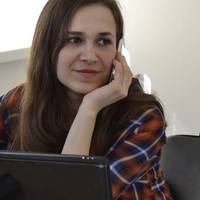- Children's and Young Adult Literature, Children's Literature, Anthropology of Children and Childhood, Picture Books, Children`s Reading, Russian Literature, and 10 moreEnglish Literature, Comparative Literature, Creative Writing, History of Childhood and Youth, Education, Nineteenth Century Studies, Nineteenth-Century Literature and Culture, Children's Literature & Culture, Digital Humanities, and Sociology of Children and Childhoodedit
The introduction to the archival block offers a brief overview of the reflections of educators, writers, and psychologists on children’s creativity. At the beginning of the 20th century, interest in children’s writing was closely linked... more
The introduction to the archival block offers a brief overview of the reflections of educators, writers, and psychologists on children’s creativity. At the beginning of the 20th century, interest in children’s writing was closely linked to solving educational tasks: using genres of personal writing (diary, letter, handwritten album/journal), educators hoped to develop students’ written speech. At the same time, children’s writing began to be endowed with independent value, as a result, the problem of immanent qualities of children’s creativity as a phenomenon began to be discussed. The nature of children’s writing has been considered from the point of view of originality/secondary. If free education teachers still saw aesthetic value in individual children’s creativity, then by the 1930s writers who patronized children’s writing stated on the one hand, the need for polishing children’s writing, and on the other hand, they fixed the inevitable influence of book and newspaper template...
Research Interests:
The article examines the experience of teachers and literary critics in the selection of poetic works and poets for the children’s reading list. Reviewers of the “Pedagogical Collection” evaluated books for students of military... more
The article examines the experience of teachers and literary critics in the selection of poetic works and poets for the children’s reading list. Reviewers of the “Pedagogical Collection” evaluated books for students of military educational institutions, and the experts of “Women’s Education” focused on the reading of women’s school students. The paper describes and analyzes approaches to the creation of gender opposed bookshelves, the nature of the requirements for poems for girls-high-school students and boys-students of military schools. Department journals performed regulative and evaluative function of the expert community, which was focused on the educational ideas of the departments. The content of “book- shelves” is considered and analyzed: “classic” authors (G. R. Derzhavin, K. N. Batyushkov, P. A. Vyazemsky, V. A. Zhukovsky, I. I. Kozlov, A. V. Koltsov, M. Yu. Lermontov, M. V. Lomonosov, P. S. Maikov, I. S. Nikitin, N. A. Nekrasov, V. A. Ozerov, A. S. Pushkin, F. I. Tyutche...
Research Interests:
В 1860–1880-е гг. русская литература закрепляется в сознании педагогов как воспитательно-образовательный материал для детского чтения. В статье рассматриваются писатели, включаемые в литературный канон для детей, и критерии, на основании... more
В 1860–1880-е гг. русская литература закрепляется в сознании педагогов как воспитательно-образовательный материал для детского чтения. В статье рассматриваются писатели, включаемые в литературный канон для детей, и критерии, на основании которых происходил их отбор. Материалом работы послужил количественный обсчет более четырех тысяч (4018) упоминаний писателей в рецензиях, обзорах, комитетских «одобрениях», списках и каталогах, размещенных в педагогических журналах: «Журнал Министерства народного просвещения», «Педагогический сборник», «Женское образование». Ключевые слова: русская классика, воспитательное значение, детское чтение, критика, литературный канон, цифровые и количественные методы
Research Interests:
The article examines the practice of selecting biographies for children’s reading in the 1860s-1880s on the basis of criticism and bibliographic lists published in the magazines “Pedagogical Collection” and “Women’s Education”. The... more
The article examines the practice of selecting biographies for children’s reading in the 1860s-1880s on the basis of criticism and bibliographic lists published in the magazines “Pedagogical Collection” and “Women’s Education”. The pantheon of heroes of the Fatherland included writers, statesmen, and rulers, saints, military leaders, artists and musicians, inventors and scientists, famous women. The recommendation of biographies for children’s reading was conditioned by the addressee, the facts of the heroes’ lives, their educational potential, socio-cultural and ideological environment. The images of women and men in biographical literature were presented unevenly. F. Resener’s book “Biographies of Remarkable Women” (published in 1878) highlighted the problem of gender inequality in biographical narratives offered for children’s reading and started the conversation about women worthy to be exemplar. This article presents the lists of recommended biographies, grouped by the type of ...
Research Interests:
“Raison d'être of Russian Classics: poets-teachers and writers-educators”. The article focuses on the 1860-1880`s when Russian Classics books was elected as educational material for children's reading. The article presents the Russian... more
“Raison d'être of Russian Classics: poets-teachers and writers-educators”. The article focuses on the 1860-1880`s when Russian Classics books was elected as educational material for children's reading. The article presents the Russian classic writers, who were included in the Canon of children`s literature. Critics, writers and teachers developed the criteria, on which they selected books in children`s reading. It is based on the materials of more than four thousand (4018) mentions of authors in the reviews, reading lists, catalogs, which was published from the 1860s to the 1880s in the pedagogical journals of three ministries (the Ministry of National Education, Military Ministry, Department of institutions of Empress Maria): “The journal of the Ministry of National Education”, “Pedagogical Digest”, “Women's education”. The author uses digital research tools.
Keywords: Russian classics, pedagogical value, criticism, children's reading, digital humanities, literary canon.
Keywords: Russian classics, pedagogical value, criticism, children's reading, digital humanities, literary canon.
